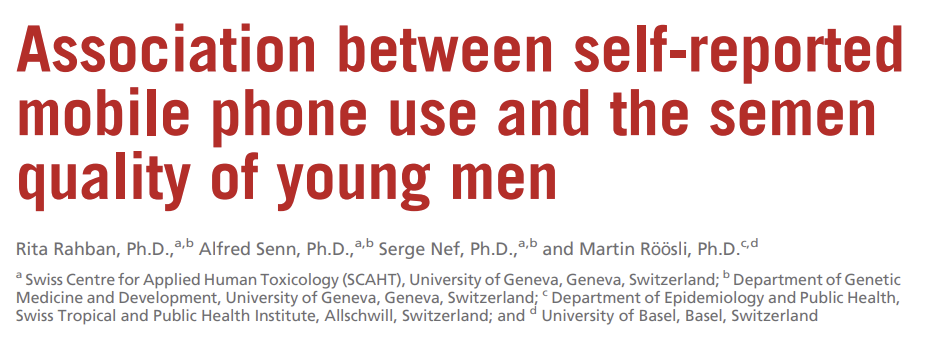Over the last decades, mobile phones have become ubiquitously used regardless of people’s age, cultural background, gender, or geographical location. However, little is known about the impact on general fertility of the radiofrequency electromagnetic fields (RF-EMF) emitted by these devices, which can be absorbed by the human body. Specifically in the case of male fertility, the available information comes mostly from in vitro or observational studies, and thus, may not fully reflect the long-term impact of carrying around a cell phone the whole time. This month, a recent study by Dr. Rahban and colleagues published in Fertility and Sterility provided the first large-scale insights into the in vivo correlation between exposure to RF-EMF and seminal parameters, by subjecting Swiss males to a cross-sectional study.
The study participants were young males recruited for military service across Switzerland, answered a questionnaire, and were categorized based on the daily frequency of mobile phone use. The study found that participants who reported a high frequency of mobile phone use, with >20 times per day, presented both lower concentration and total sperm count – and no alterations in motility and/or morphology – in their ejaculates in comparison to low-frequency users (< once per week), and were predicted to have an increased risk of having these seminal parameters altered. These results were maintained even when corrected for cofounding factors, including general characteristics, like body mass index, and lifestyle factors, such as alcohol and tobacco consumption.
Additionally, more profound effects were reported on the mentioned seminal parameters of samples from patients recruited during the first period of the study (2005-2008). The authors also highlighted in their study that the reason behind this tendency may be related to the improvement in mobile network technologies, since it coincided with the transition from 2G to 3G and 4G, with the former emitting higher levels of radiofrequency and thus, seeming worse for the semen quality.
While the advancement in technological features of mobile phones seemed to have lowered the impact in male fertility, it remains to be elucidated whether a direct correlation exists between the extent of the detrimental effects of using these devices and the amount of RF-EMF absorbed by the human body. Additionally, the authors hypothesized that the decrease in sperm concentration and total sperm count may be partially due to the increase in temperature (+ 0.5°C) by the device, which could affect spermatogenesis. Nonetheless, no clear correlation was found when studying where the mobile phones were stored while not in use, either in close contact to the body or somewhere else, and thus, discarding the increased temperature as the cause of altered seminal parameters. In any case, this study constitutes a starting point on the in vivo effects of long-term exposure to mobile phones and opens the field for more questions on how we could be silently affecting our fertility. For more information, readers are advised to follow-up the study on DOI: 10.1016/j.fertnstert.2023.09.009.

